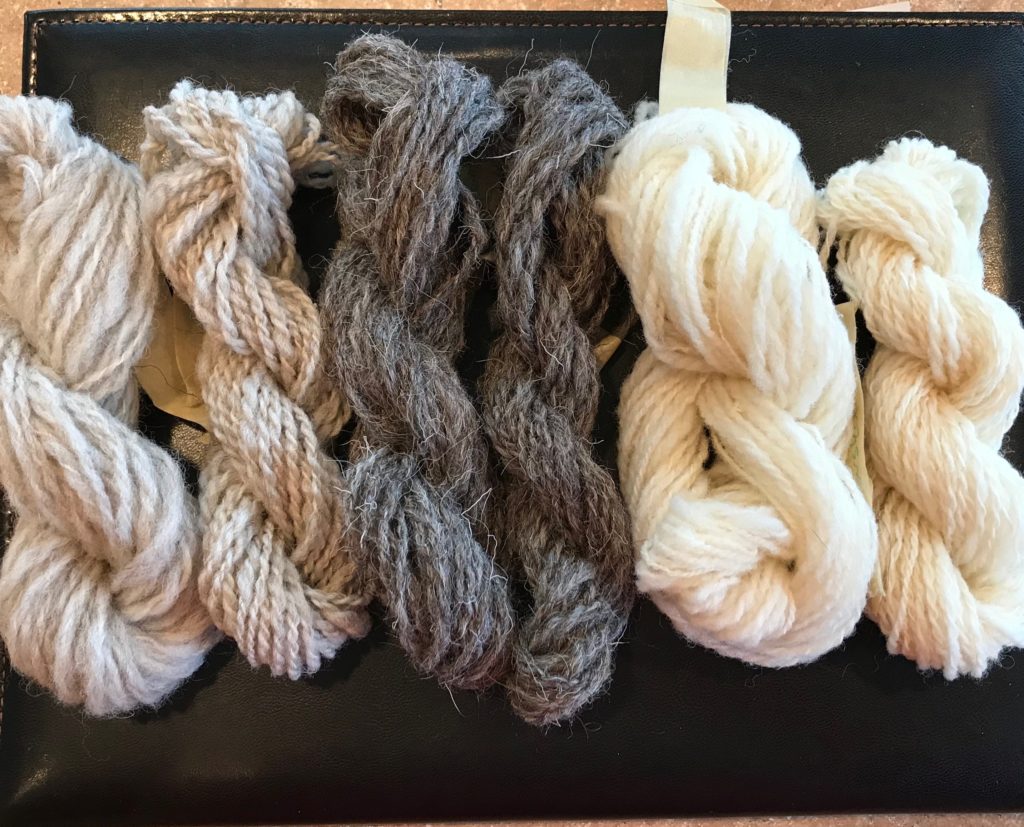
I may have mentioned that historically I’m a terrible blogger…and now I’ve proven it once again! Of course I also quit a job to move to a new state (Oregon) with my husband who got a new job, and there were holidays…but still. Bad blogger.
So, New Year, New Start. Having moved and being unemployed (at the moment) means I have time to do a lot of crafty things, and I’ve started my breed study in earnest. What is a breed study, you ask? I have a box 1 oz samples of the fleece of of 32 breeds, and I’m choosing which breed I spin pretty randomly. I’m splitting each 1 oz bit into two 1/2 oz. parts so I can spin one worsted and one semi-woollen or woollen. My worsted spins are being done with a short forward draw straight from the combed tops – my comfort zone!
I was a lucky lady and received a blending board as a Christmas present, so I’m making rolags and doing my semi-woollen or woollen spinning from them using supported long draw. I’m just learning this technique and have had to spit splice my singles back together during plying…but hopefully I’m getting better along the way!
If you want to know more about the specific breeds and their origins, I recommend The Fleece and Fiber Sourcebook by Deborah Robson and Carol Ekarius. I’m trying to read up on each breed before I start spinning it.
Herdwick

I started my study way back in September with this Herdwick sample. As you can see, it is hairy! It is full of kemp and guard hairs, and is pretty rough no matter how you spin it. I imagine that if you got a raw fleece it might be possible to separate the finer fibers from the rest through carding, but it would be quite a process and I’m not sure how much usable fiber you’d end up with.
I used a regular short forward draw on the worsted sample. A smooth result was not going to happen, so I tried to let the wool do what it was going to do.
I did the semi-woollen sample here using long draw, but from the commercial top – at the time I didn’t have a way to re-prep it for woollen spinning so I just did the best I could. I think that either of these samples would be great for a hard wearing woven project – but I’m not a weaver. So I knitted little swatches, and it was a bit like knitting with twine. I kind of like the result, but the process wasn’t super pleasant!

The samples overall look a lot the same – partly that’s the wool and partly that’s the prep – but I don’t think my semi-woollen sample would have been that much different even if I’d carded it. Perhaps sometime I’ll have the opportunity to find out!
Swaledale

I loved this fiber, start to finish. I chose it as my second fiber to sample because it was a pretty color, and it didn’t disappoint! I spun the first sample using short forward draw and plyed for a balanced yarn (although it wasn’t). I like the smoothness of the sample, as well as the definition in the plys. It’s not next to the skin soft, but it would be fantastic for outerwear.
This was a great fiber to start with for a) learning to make some of my first rolags on my blending board and b) using as my early rolags to create semi-woollen yarn. It’s toothy enough to hang together while I learn, and the result is so fluffy and lovely! I loved how it bloomed in its warm blocking bath. If I’d had one, I would have used a little plunger to felt it up a bit – I do think it would pill quickly in a garment that got any abrasion. (A plunger? What is she talking about? Beth Smith explains it all here.)

Although this could be a hard wearing yarn if spun tightly and knitted or woven tightly, I found that both samples were pretty lovely to knit on a size 7 needle. I wasn’t trying for a specific weight, but managed just about a worsted weight for both my yarn samples.
I would definitely spin some Swaledale again sometime – maybe for a nice cardigan!
Charollais

My final samples for this post were Charollais – a creamy, slightly toothy French breed. Although it’s not technically a down-type breed, I think the character of the wool is much the same. It’s quite crimpy (although I can’t say if its a spiral crimp) and a bit rough, but would make fantastic sock yarn.
This fleece has a short staple, so I spun it pretty tightly on my worsted spin – which resulted in a slightly wirier yarn than I meant to make. The semi-woolen sample is a little nicer, but I wish I’d done it with a teensy bit less twist. Or perhaps I wish that I’d been a little more consistent in the diameter of my singles for both spins. My accidental thick-and-thin spots are quite evident in both the worsted and the semi-woollen samples and swatches, which I’m not wild about…but I actually like the way the swatches bloomed in their warm baths. Again, the woollen-spun yarn might have benefited from a plunger treatment.

I knit both of my swatches on size 6 needles. Even though I said my worsted sample yarn was a little wiry, I actually think that with a bit of practice this could be a good sock yarn. There is probably a “solid but not like knitting twine” happy middle ground that would result in a nice fabric – I can feel it a bit in the less fine-sections.

Hey look! I found the comments box, and it works! Good job, Alison!